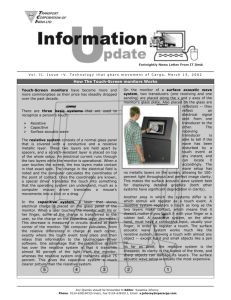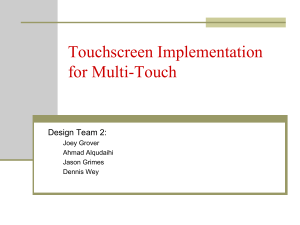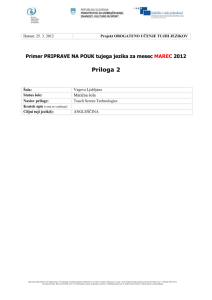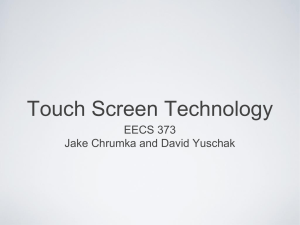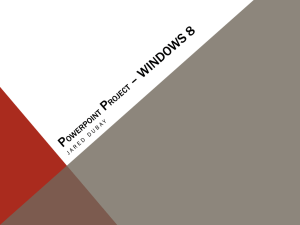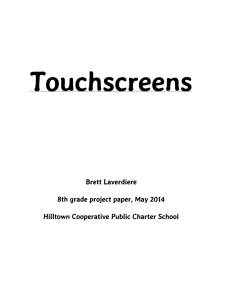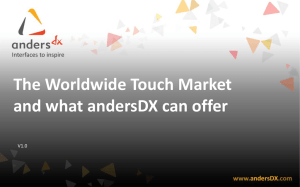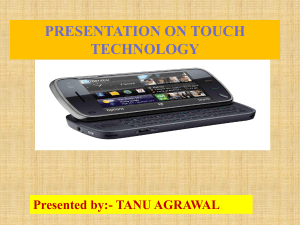TOUCH SCREENS - WordPress.com
advertisement
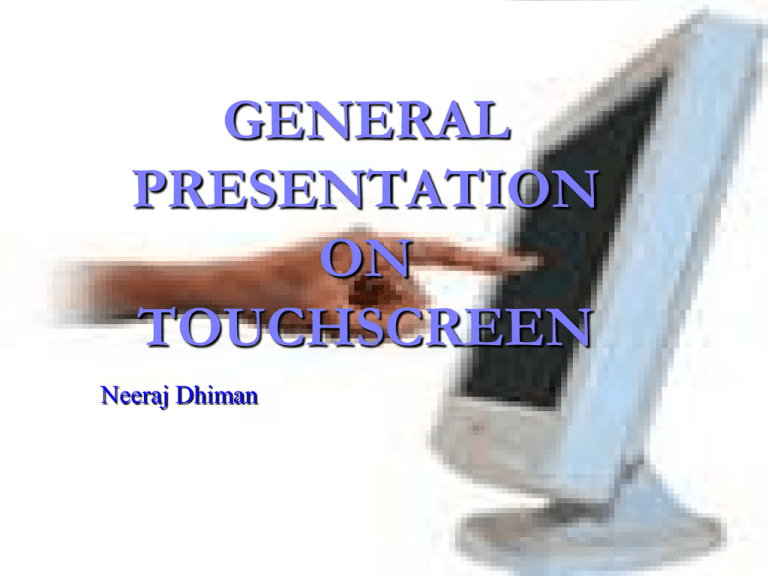
GENERAL PRESENTATION ON TOUCHSCREEN Neeraj Dhiman What is Touchscreen An input/output device that accept input directly from the monitor , the user touches words, graphical icons, or symbols displayed on screen to activate commands. A touch screen is a computer display screen that is sensitive to human touch, allowing a user to interact with the computer by touching pictures or words on the screen. History of Touchscreen In 1971, the first "touch sensor" was developed by Doctor Sam Hurst (founder of Elographics) while he was an instructor at the University of Kentucky. This sensor called the "Elograph" was patented by The University of Kentucky Research Foundation. In 1974, the first true touch screen incorporating a transparent surface came on the scene developed by Sam Hurst and Elographics. In 1977, Elographics developed and patented five-wire resistive technology, the most popular touch screen technology in use today. On February 24, 1994, the company officially changed its name from Elographics to Elo TouchSystems. How Does A Touchscreen works A basic Touchscreen has three main components: A Touch sensor A Controller A Software driver. 1. Touch Sensor A touch screen sensor is a clear glass panel with a touch responsive surface. The touch sensor/panel is placed over a display screen so that the responsive area of the panel covers the viewable area of the video screen. There are several different touch sensor technologies on the market today, each using a different method to detect touch input. The sensor generally has an electrical current or signal going through it and touching the screen causes a voltage or signal change. This voltage change is used to determine the location of the touch to the screen. 2. Controller The controller is a small PC card that connects between the touch sensor and the PC. It takes information from the touch sensor and translates it into information that PC can understand. The controller is usually installed inside the monitor for integrated monitors or it is housed in a plastic case for external touch add-ons/overlays. The controller determines what type of interface/connection you will need on the PC. Specialized controllers are also available that work with DVD players and other devices. 3. Software Driver The driver is a software update for the PC system that allows the touchscreen and computer to work together. It tells the computer's operating system how to interpret the touch event information that is sent from the controller. Most touch screen drivers today are a mouse-emulation type driver. This makes touching the screen the same as clicking your mouse at the same location on the screen. Touchscreen Technologies There are basically three types of touch screen technologies: Resistive Capacitive Surface wave Resistive Touchscreen Technology The Resistive system consists of a normal glass panel that is covered with a conductive and a resistive metallic layer. These two layers are held apart by spacers, and a scratch-resistant layer is placed on top of the whole setup. An electrical current runs through the two layers while the monitor is operational. When a user touches the screen, the two layers make contact in that exact spot. The change in the electrical field is noted and the coordinates of the point of contact are calculated by the computer. Once the coordinates are known, a special driver translates the touch into something that the operating system can understand, much as a computer mouse driver translates a mouse's movements into a click or a drag. Capacitive Touchscreen Technology The Capacitive, a layer that stores electrical charge is placed on the glass panel of the monitor. When a user touches the monitor with his or her finger, some of the charge is transferred to the user, so the charge on the capacitive layer decreases. This decrease is measured in circuit located at each corner of the monitor. The computer calculates, from the relative differences in charge at each corner, exactly where the touch event took place and then relays that information to the touch-screen driver software. Advantage :-It transmits almost 90 percent of the light from the monitor, whereas the resistive system only transmits about 75 percent. This gives the capacitive system a much clearer picture than the resistive system. Surface Acoustic Wave Touchscreen Technology A surface acustic wave technology, two transducer (one receiving and one sending) are placed along the x and y axes of the monitor's glass plate. Also placed on the glass are reflector -they reflect an electrical signal sent from one transducer to the other. The receiving transducer is able to tell if the wave has been disturbed by a touch event at any instant, and can locate it accordingly. The wave setup has no metallic layers on the screen, allowing for 100-percent light throughput and perfect image clarity. This makes the surface acoustic wave system best for displaying detailed graphics (both other systems have significant degradation in clarity). Comparing Touchscreen Technologies 4-Wire Resistive Touch screens 5-Wire Resistive Touchscreens Capacitive Touchscreens PenTouch Capacitive Touchscreens 4-Wire Resistive Touch screens 4-Wire Resistive touch technology consists of a glass or acrylic panel that is coated with electrically condictive and resistive layers. The thin layers are separated by invisible separator dots. When operating, an electrical current moves through the screen. When pressure is applied to the screen the layers are pressed together, causing a change in the electrical current and a touch event to be registered. 5-Wire Resistive Touchscreens 5-Wire Resistive touch technology consists of a glass or acrylic panel that is coated with electrically condictive and resistive layers. The thin layers are separated by invisible separator dots. When operating, an electrical current moves through the screen. When pressure is applied to the screen the layers are pressed together, causing a change in the electrical current and a touch event to be registered. Capacitive Touchscreens A capacitive touch screen consists of a glass panel with a capacitive (charge storing) material coating its surface. Circuits located at corners of the screen measure the capacitance of a person touching the overlay. Frequency changes are measured to determine the X and Y coordinates of the touch event. PenTouch Capacitive Touchscreens The PenTouch Capacitive screen is a durable Capacitive type touchscreen with an attached pen stylus. The PenTouch screen can be set to respond to finger input only, pen input only, or both. A capacitive touch screen consists of a glass panel with a capacitive (charge storing) material coating its surface. Circuits located at corners of the screen measure the capacitance of a person touching the overlay. Frequency changes are measured to determine the X and Y coordinates of the touch event. THANKS ANY QUERY
